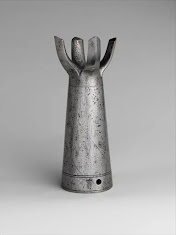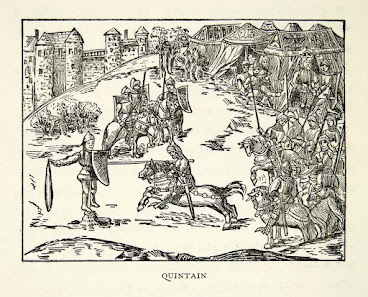A Background of History's First Extreme Sport
A Background of History's First Extreme Sport
The most popular form of entertainment across the world is perhaps the art of sports. However, did you know the world's first extreme sport was jousting? In the medieval ages, tournaments were equivalent to our Olympics (it was a pretty big deal). So, let's travel back in time and learn all about the famous art of tournaments and jousting.
Armour and Weaponry
Armor started off as padded linen and leather in the 13th century. However, when plate armor became popular in the 14th century, it quickly took over. Places more likely to be hit (the left shoulder, chest, and right side of the helmet/helm) were reinforced with an extra metal plate. As well as this, a manifer, a heavy steel gauntlet, protected the lance hand when jousting(1). Knight's horses(6) were also well protected. They typically had a padded or metal chest protector, as well as a metal plate protecting their head(1).
For jousting specifically, the frog-mouth helmet was mainly used. A horizontal slit was used for visibility but was so narrow that the knight could only see out of it leaning forward when he was charging at the opposing knight. However, it also gave maximum protection when, at the last second, the knight would pull his head back(2). This helmet was designed to protect knights from blindness from splinters from the broken lance. Despite their best efforts, accidents still happened. King Henry II of France suffered a fatal wound in his eye and died when a sliver of lance pierced him(3).
Shields(6) were often made of wood or leather with metal reinforcements. They varied in shape and size. Sometimes, a resting spot was made for the lance called a poire, but this was mainly in the 15th century. Other times, the shield was strapped to the shoulder so it would not fall when struck. Additionally, knights proved their lineage and were easily identifiable by wearing their 'coat of arms' on their shields (1).
 |
| A multi-pronged lance head Nicknamed 'arms of courtesy' (1) |
Lances were the most popular of weapons during tournaments and jousting. They were 2.4-3 meters in length and commonly made of ash/cypress. They were hollow and had 3-4 pointed heads to reduce injury(1). Swords were also used in tournaments. They were long, double-edged, with a simple cross guard to protect the hand. They were blunted to again reduce injury. Generally, they were not used during the later centuries since jousting was so popular. However, if a knight got unsaddled during a joust, they could proceed in hand-to-hand combat if they wished(1).
Tournaments
A 15th-century depiction of Wenceslaus I
in full tournament gear (1)

in full tournament gear (1)
Tournaments(6) first began in northern France during the 11th century(1). They started off as lethal free-for-alls. Knights would fight against each other in a mock battle with little to no rules. Four or five knights might target an opposing knight and drag them off their horseback to try and overpower them(2). Defeated knights had to surrender their gold or armor to the winning knights. Fun fact: Young William Marshall was penniless before tournaments gave way to his fame, and he became Regent of England due to his success(2). Tournaments were usually held to celebrate a marriage or coronation and could go on for days at a time (1). However, because of their brutality and lack of mercy, the Church condemned tournaments as inventions of the devil. The Church went so far as to declare that any knight killed during a tournament was refused burial on holy ground (2). Eventually, these tournaments gained some civility and became grand courtly spectacles. Enter jousting.
Jousting
Jousting replaced the all-out melee event in tournaments. It became popular because it was much easier to display one's skills in one-to-one combat. Only good, honorable knights were allowed to participate. Anyone who had a criminal record or disreputable reputation was banned from participating(2). This could be why some knights chose to remain anonymous in tournaments. The first recorded joust was in 1066, but a century later, it spread like wildfire(3). Jousting was created as a result of the feudal system. It required wealthy landowners and nobles to provide knights to fight for the king during the war, and jousting was a practical way for knights to get hands-on experience with combat and fighting skills(3). But it quickly transformed into a form of popular entertainment.
Jousting took place in the lists, much like our modern-day arena. It was a roughly rectangular space covered with sand and straw and was about 100-200 meters in length. Knights were separated by a barrier called the tilts, which started off as a rope but, in the 15th century, developed into a wooden barrier that was about 6 ft high(1).
 |
| A set of rules compiled in England in 1466 stipulated rewards would be given for the above actions(1) |
If knights won their jousts they could receive prizes like gold, jewels, fine swords, or a lady's affection. Ladies might give certain tokens to knights they favored in a joust, like a veil or a handkerchief, which the knight would usually tie on the end of his lance(1).
If jousting was not done in a tournament setting, it would also be done at a siege between battles with knights from opposing armies. These could be lethal. For instance, Sicily in 1062 CE, Wurzburg in 1127 CE, and numerous times during the English-Scots wars of the 14th century(1). Grudge matches were also performed where lethal weapons were used if there was a dispute amongst knights(1).
 |
| A 1939 print depiction of Medieval Ages quintain (5) |
Popular Jousters
Like modern-day sports today, jousting and tournaments also had their MVPs...and their letdowns.
 |
| George Clifford's portrait with the Queen's glove (2) |
Henry VIII: The King of England also nicknamed the ultimate celebrity jouster. He loved organizing and taking part in tournaments. He possessed many sets of magnificent jousting armor and had his own specialized armor factory at Greenwich Palace. However, even kings suffered injuries in jousting. In 1524 he suffered a blow above his right eye, and in 1536 was trapped under his horse and remained unconscious for two hours. Some say this led to him being a tyrant in his later years of rule(2).
George Clifford: The Queen's Champion and Earl of Cumberland(6) in 1590. His portrait shows him wearing the Queen’s glove in his hat signifying he would fight anyone who challenged her(2).
The Unfortunate Decline
In the 16th century, the development of muskets and firearms led to the downfall of jousting as a form of combat training(3). Additionally, horsemanship and fighting on foot were more appreciated in the 16th century(1). Therefore, competitive jousting essentially vanished leaving it as more of a form of entertainment with choreographed routines. Queen Elizabeth's reign saw the tournament's last blaze of glory with a half-hearted tournament held in 1620(2). And by the middle of the 17th century, traditional jousting was officially a thing of the past(3). The golden age of chivalry and knighthood had passed signifying the end of jousting and tournaments.
Resources:
6. https://www.metmuseum.org/art/online-features/metkids/time-machine/results/1400%20-%201600/all/all





Comments
Post a Comment